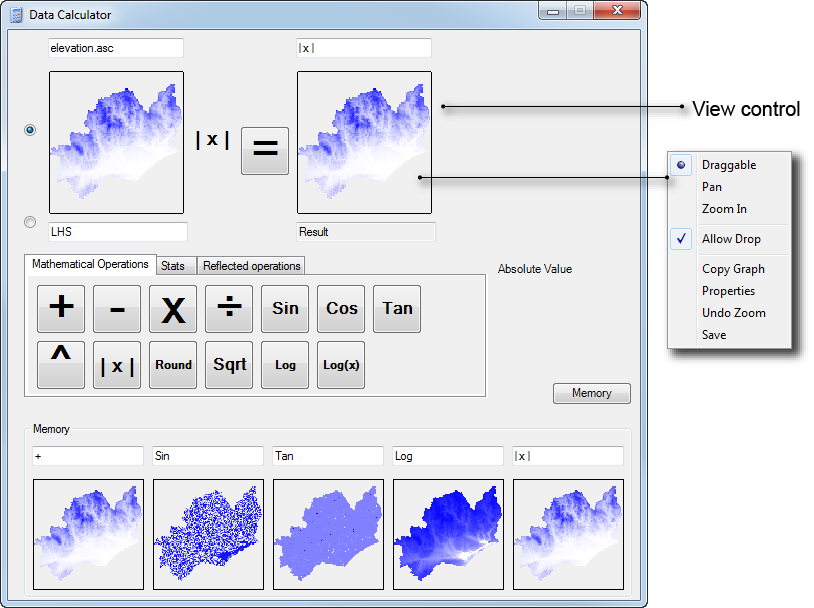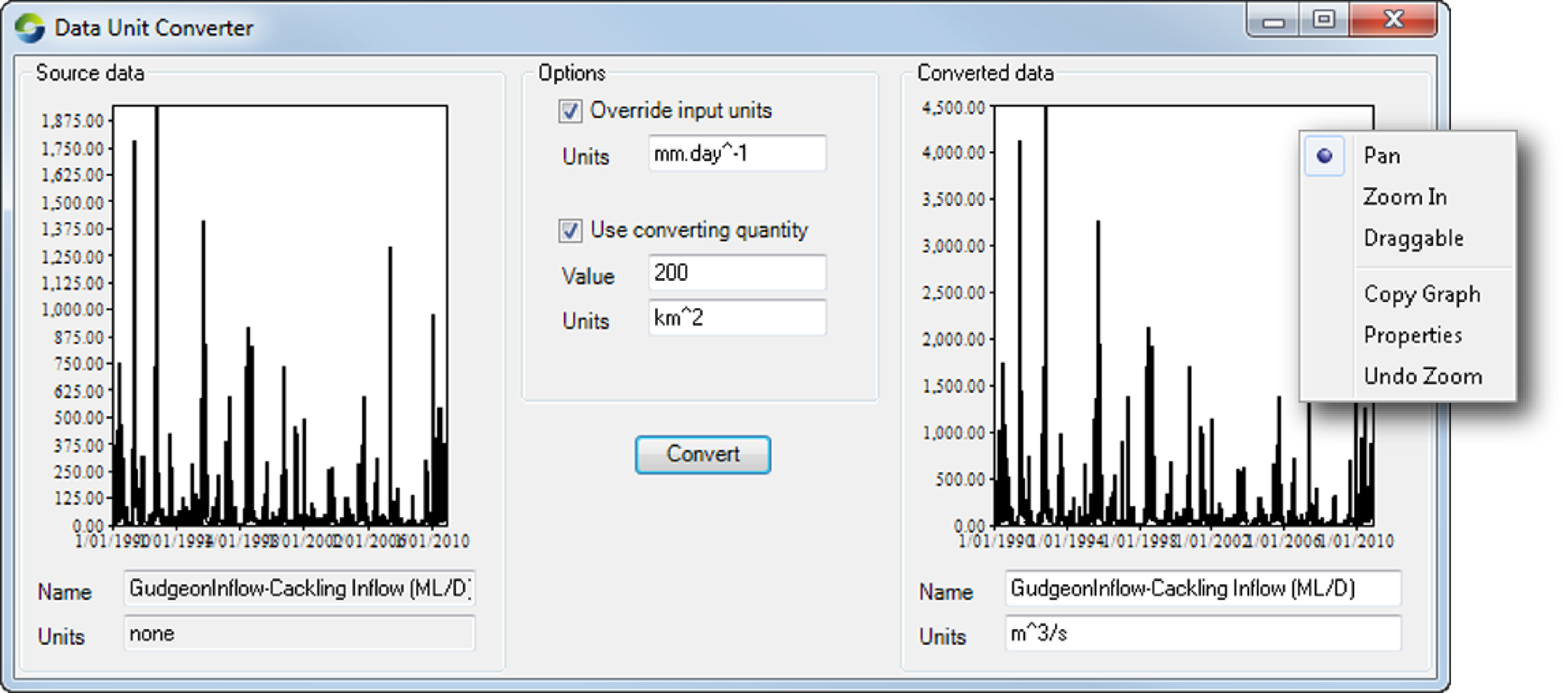Note: This is documentation for version 4.11 of Source. For a different version of Source, select the relevant space by using the Spaces menu in the toolbar above
Analysis tools
This section describes the Source processing tools that are installed by default, accessible via the Tools menu and sub-menus.
Data calculator
The Data calculator (accessed via Tools » Data Calculator Tool) can be used to analyse spatial raster data and time series through the use of simple arithmetic operators, or to compare data sets.
You can use rasters, time series or numbers as operands as follows:
- Drag and drop the raster data or time series into either of the two view controls (raster or time series are displayed in a small window called a View Control (Figure 1), or use a combination of a raster/time series and a number.
- Use the radio buttons to select either the view control or numeric values as left and right operands;
- Click one of the basic operations buttons (addition, subtraction, square root etc). The data calculator displays the operand you selected; and
- Click =, and the result, either raster/time series or numeric, appears in the results area on the right.
The memory feature of the data calculator allows you to save previous results, either numeric or raster/time-series.
Click Memory to open the memory area. To save a result raster/time series into the memory, click on the 1st or 2nd operand, or result, view control, then drag and drop the contents into your desired memory view control. The label above each view control resides shows the mathematical operation leading to the result stored there. Figure 3 shows the memory area with several stored results.
Figure 1. Data Calculator with data stored in memory
To save any of the results, right-click any of the view controls, and choose Save from the pop-up menu. You can also drag the contents of any view control into any other view control or graph form anywhere else in Source.
The Stats tab gives a statistical summary of the data sets that have been analysed with the Data Calculator. The Reflected Operations tab provides additional data manipulation operations, such as Merge, find Maximum value or multiply two rasters. It allows you to perform customised operations. You can use a plugin to create these operations, which then appear on the list, and can be performed on various data sets.
Data modification tool
The Data modification tool allows you to edit data inputs depending on conditions that you wish to specify. Choose Tools » Data Modification Tool to open the tool, as shown in Figure 2 and carry out the following steps to change the data inputs:
- Click Open under Data loader, which displays the file name in the box below, along with the file on the right;
- Under Condition builder, click Add to add a condition. The input data, conditional operator and condition value can be accessed by hovering and clicking on the relevant area in the condition builder. A drop-down menu appears;
- Click Name to associate a name with the condition;
- Clear can be used to clear the list of conditions if it gets too long and is no longer required;
- Under Rule Executer, you can specify the output for specific aspects of the input. For example, if the condition reaches a certain value, the result will be 0; and
- Click Execute, and the output will be displayed in Result, which can be saved by clicking Save.
Figure 2. Data modification tool
Data unit converter
As its name suggests, this tool converts units (embedded into data files) from one type to another. It is accessible via Tools » Analysis Windows » Data Unit Converter (Figure 3).
Figure 3. Data Unit Converter
Use the converter as follows:
- Drag and drop a data file onto the Source data window in the left side panel. If there are units in the data file, they will appear in the units field below the input window;
- Enter the output/target units in the Units field on the right side (under Converted Data). You can either use the default name (copied from the source data file) or enter a new name; and
- Click Convert. To save the converted file, drag it somewhere else in Source that has a Save as function. This is because you cannot right-click the converted data graph and save it.
If there are no units in the input file, you must force the data converter to assume that there are input units by ticking the Override input units checkbox and entering the "assumed" unit under Units. For example, you have a CSV file containing dates and rainfall, but it does not contain any units. You want an output containing metres per day. Assume the input is in mm/day:
- Drop the input file into the Source data window;
- Tick the Override units checkbox;
- Enter mm.day-1 into the Units field;
- In the converted data window, enter the name for the converted data set;
- In the converted data window units field, enter m.day^-1 (metres per day); and
- Click Convert. The converted data should be scaled down.
You can also scale the converted output to your desired units by ticking the Use converting quantity checkbox. Enter a non-zero value into the Value field and click Convert to scale the output by both the value and the difference in magnitude of the units eg 0.5 mm/h converted to m/h with value 3 ends up being 0.0005 m/h. Note that you must specify both the source value and the target units.
Right clicking in the Converted data dialog will reveal a pop-up menu of options. This enables zooming, panning, dragging, formatting and copying a picture of the output graph to the paste buffer.
Graph Control
Choose Tools » Graph Control to open a charting tool window, which can be used to drag data and display it. Refer to Using the Charting Tool for details.


